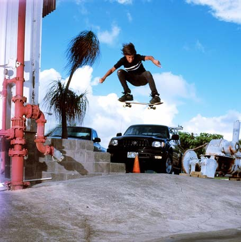How to Ollie
The Ollie
The Ollie

Ah, the Ollie. If skateboarding tricks were represented as a tree, the Ollie would be the trunk of the tree. Terrible analogy, I know, but the Ollie is truly the foundation of almost all flatland skateboarding tricks and is usually the first trick a beginner learns.
Once you master the Ollie, you can begin exploring more advanced tricks such as the Kickflip or Heelflip, or you can take your Ollies to the next level and jump off/over/onto obstacles!
Requirements for the Ollie
Before learning the Ollie, you want to be comfortable riding around on your skateboard.
Ollie Foot Placement
Place your back foot, with the ball of the foot on the middle of the tail.
Place your front foot an inch or two behind the front bolts, in the center of the board. Generally, the farther back (toward the tail) your front foot is, the higher you will Ollie.
When beginning, it’s a good idea to have you front foot a little farther back to get a feeling of the dragging motion.
Balance
You want to stay over your board as you Ollie, keeping your weight in the center. Make sure you have all four wheels on the ground and you are not leaning towards one side.
Pop
- As you get ready to Ollie, bend your knees. Experiment with how far down you bend.
- The more you bend your knees, the higher your Ollie will be. However, it can be easy to lose your balance when bending down too much.
- Slam down on the tail with your back foot. Give a quick, hard, clean slam. Slam straight down; do not “scoop” the tail as you pop
- As you slam, you’ll also want to jump into the air off of your back foot and pull your foot up. This part of the Ollie requires some practice to get the timing down.
Drag
- The dragging motion of the front foot is what actually gets the board up in the air. Timing the drag along with the pop and jump is by far the most difficult part of learning the Ollie. Take your time with this step
- As you pop and jump, drag your front foot along the griptape up towards the bolts. This dragging motion pulls the skateboard higher off the ground.
- You’ll want to lean forward as you drag. If you have you’re the majority of your weight on the tail, your board will pop up crooked and will not level out.
- As you reach the end of your drag, you’ll want to “suck up” your knees, bringing them as high as you can.
- Focus on hitting your chest with your knees. As long as you’re not leaning too forward to too backwards, the board will flatten out by itself.
Landing
If you maintained your balance throughout the whole trick, your feet should land on the bolts. Bend your knees to absorb the shock of the landing and ride away!
Learning the Ollie
Many skaters learn the Ollie by practicing stationary on the grass or carpet. This keeps the board in place, so you don’t have to worry as much about your balance and your body can focus more on the actual motions involved in this trick.
However, learning tricks stationary can cause bad habits to form. For this reason, I strongly recommend learning the Ollie both moving and stationary. Start on the carpet or grass.
When your Ollies begin to look somewhat decent, start practicing moving at a slow speed. As you get higher and more comfortable with Ollies, completely abandon practicing them stationary and do them at faster speeds.
After you are able to Ollie while rolling, take your Ollies to…
Flatground Tricks NEXT
Troubleshooting the Ollie
